Middle East Cybersecurity Market Size
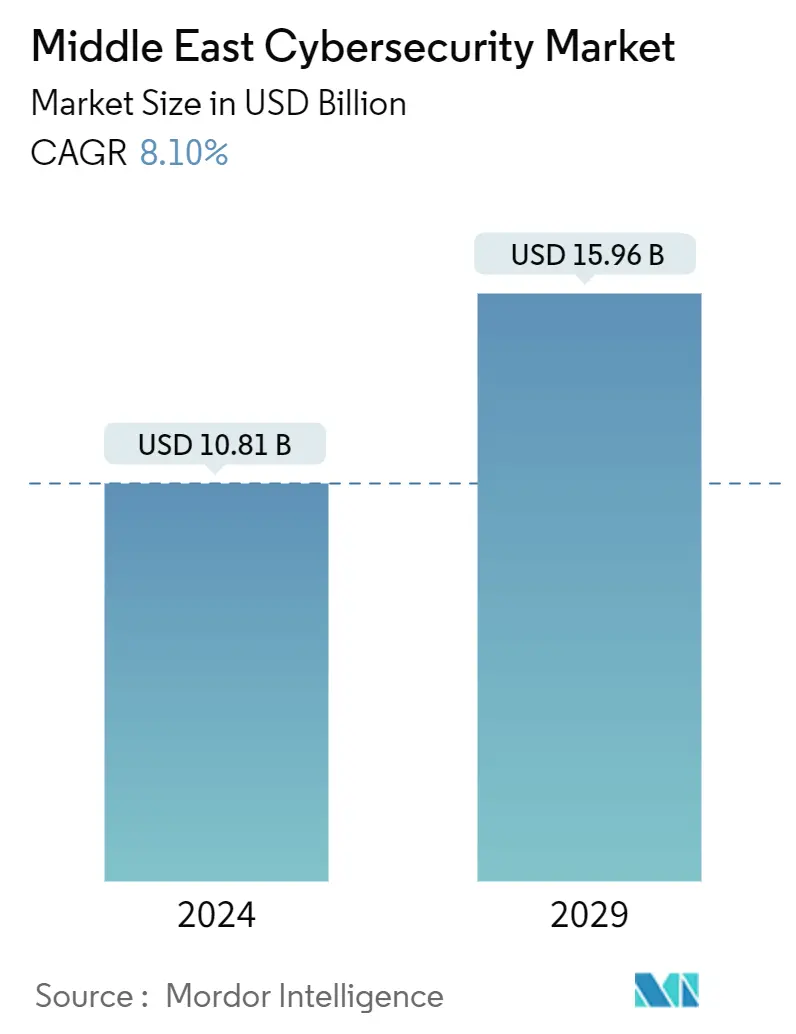
| Study Period | 2019-2029 |
| Base Year For Estimation | 2023 |
| Market Size (2024) | USD 10.81 Billion |
| Market Size (2029) | USD 15.96 Billion |
| CAGR (2024 - 2029) | 8.10 % |
| Market Concentration | Low |
Major Players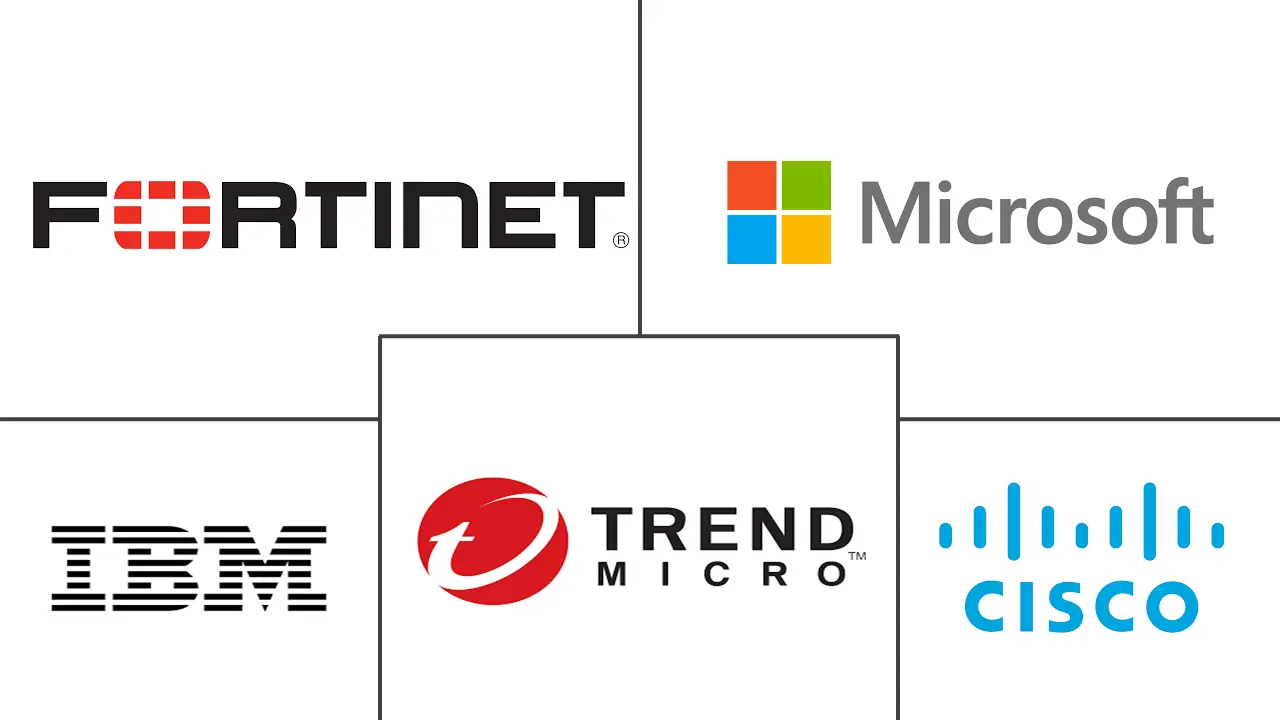
*Disclaimer: Major Players sorted in no particular order |
Middle East Cybersecurity Market Analysis
The Middle East Cybersecurity Market size is estimated at USD 10.81 billion in 2024, and is expected to reach USD 15.96 billion by 2029, growing at a CAGR of 8.10% during the forecast period (2024-2029).
The key drivers contributing to the increase in the adoption of data-intensive approaches and decisions with the growth include the increase in the number of cyberattacks in the Middle East with the growing digitalization.
- The pandemic boosted digital transformation in the Middle East and increased the demand for cybersecurity solutions to protect remote work environments. Businesses prioritize robust cyber defenses, fueling growth in the cybersecurity market across the region.
- Earlier, the Middle East did not witness a significant target for cyberattacks. Regions such as Europe and North America have always been majorly affected by cyber threats. However, rapid digitalization in countries such as Saudi Arabia and the UAE has recently boosted the number of connected devices, opening new gateways for cyberattacks.
- Governments in the region are also growing their investments in information and communication technology. As a result, the region's social infrastructure, financial sector, government services, schools, and hospitals have been deploying interconnectivity solutions with less attention to these developments' security requirements.
- However, the significant factors driving the threat of cyberattacks in the Middle East are increasing vulnerabilities in digital communications networks and supply chains, rapid development in the user base of online consumers, and, chiefly, the deficient cybersecurity infrastructure.
- Traditional authentication methods, such as passwords, PINs, and security tokens, have been the cornerstone of digital security for many years. Users must remember and provide unique credentials to access their accounts or sensitive data. While these methods are popular, they also have drawbacks, such as weak passwords, reused passwords, and vulnerability to phishing attacks. The high reliance on these traditional authentication methods is posing a challenge to the market's growth.
- As the economy moves toward digital transformation aligned with Saudi Vision 2030, more businesses are adopting cloud solutions and other online application platforms. In addition, the number of accessible components remotely is also rising across industries, providing additional points of vulnerability. These factors contribute to the increased cyber-attack rate, driving the demand for effective cybersecurity measures in the post-COVID-19 Scenario.
Middle East Cybersecurity Market Trends
Cloud to Witness Significant Growth
- Numerous factors, including scalability, flexibility, ease of accessibility, and cost-effectiveness, drive the growing adoption of cloud-based cybersecurity solutions. The increasing reliance on remote and mobile capabilities contributes to the demand for cloud-based cybersecurity. Cloud solutions can facilitate secure access and monitoring of systems from any location, supporting the needs of modern, flexible work environments.
- Deploying cloud-based services can significantly reduce the Capex requirement as the companies need not invest in hardware components. Cloud solutions also enable better prediction of the cost of an application, and companies do not need to incur much upfront cost to incorporate the technology. The hardware and IT support savings make cloud-based solutions much more affordable.
- The growing collaborative efforts of cloud solution providers are driving cloud adoption in the public and private sectors in the country and developing the cloud environment. This growth in adopting cloud solutions creates a need for cloud-based cybersecurity solutions. Saudi Arabia is anticipated to drive the demand for cloud-based cybersecurity solutions due to the rapid adoption of cloud technology and growing investment in digital transformation. As organizations increasingly rely on cloud-based services and data storage, the need for this solution is rising in the country. In addition, companies such as Oracle Corp plan to boost their cloud offerings in Saudi Arabia and the UAE with more cloud regions.
- Overall, the growth of cloud-based solutions is driven by its ability to address the evolving needs of organizations in an increasingly digital and interconnected environment. Cloud-based cybersecurity solutions are expected to gain prominence as organizations encounter the complexities of a dynamic threat landscape and undergo digital transformations.
- The surge in 5G subscribers across the Middle East is catalyzing digital transformation by delivering heightened connectivity and accelerated data transfer speeds. This technological development empowers businesses to adopt advanced applications and innovative solutions. However, the expanded digital landscape also exposes businesses to heightened cybersecurity threats. As reliance on 5G infrastructure grows, so does the imperative for robust cybersecurity measures to safeguard against potential vulnerabilities and cyberattacks.
- The demand for cybersecurity solutions in the Middle East region is escalating, driven by the need to fortify networks, protect sensitive information, and ensure the resilience of critical digital assets in the face of evolving cyber threats. According to Ericsson, 5G subscriptions in the GCC are expected to reach 74.59 million by 2029. In 2023, there were 25.74 million 5G subscriptions in the GCC.
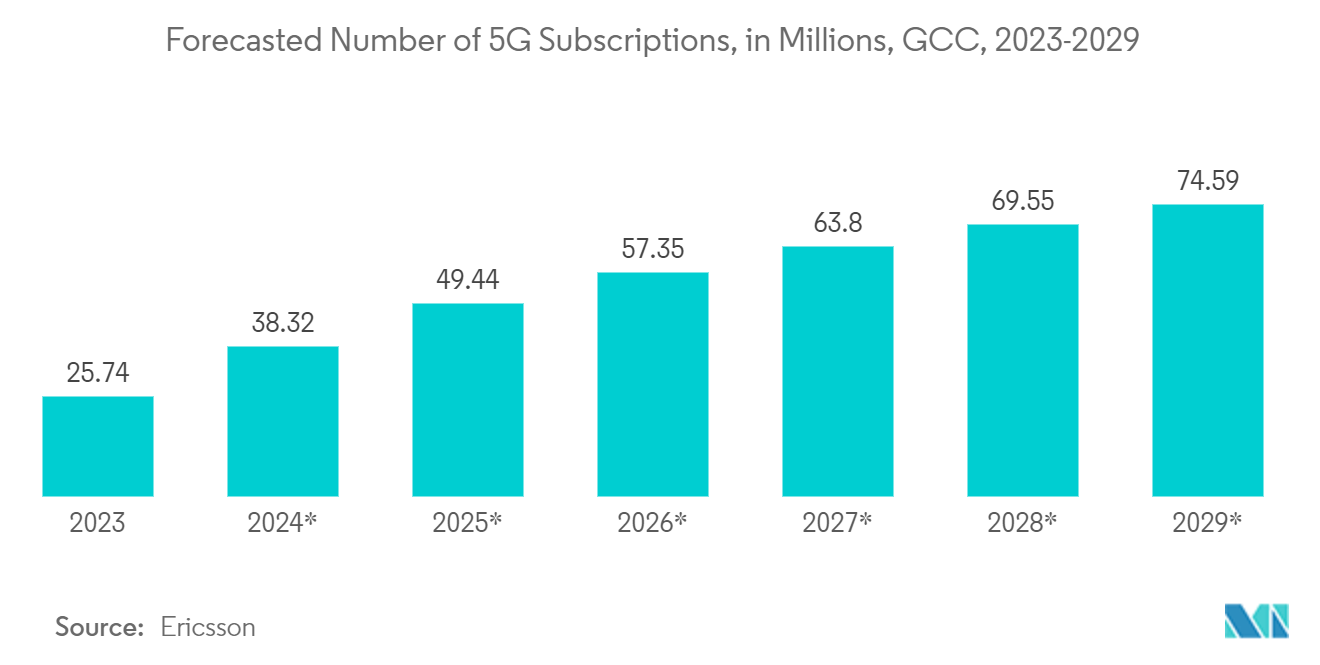
United Arab Emirates (UAE) to Witness Major Growth
- The Middle East region has one of the most sensitive areas of cyberspace in the world. The combination of high digitization rates and a thriving economy is drawing the attention of malicious actors' attention worldwide. According to Microsoft, from July 2022 to June 2023, nearly 38% of the network interruptions in the Middle Eastern nations by nation-state or state-affiliated cyber threat performers were absorbed against Israel. The UAE ranked second in the part of threats in the region.
- The UAE is one of the prominent economies. It has focused on moving toward a digital economy for the last few years, combined with government initiatives and increased interest from global and local vendors. In addition, government initiatives such as the "Cyber Sniper" to sharpen the skills of national talents, raise awareness on cybersecurity issues, enhance the cybersecurity capabilities of specialized government personnel, and enrich the experiences of professionals in federal entities are expected to impact the cybersecurity landscape in the region positively.
- Further, with the emphasis on digitalization, its vulnerabilities are also growing, driving the demand for cybersecurity solutions and services in the country. For instance, according to the head of the UAE's Cybersecurity Council, over 71 million attempted cyberattacks in the UAE have been blocked in the first three quarters of 2023.
- The growing pace of technology adoption in the UAE, including remote work tools and migration to the cloud, has bolstered the demand for cybersecurity solutions and services in the country's businesses. Global market vendors are capitalizing on the opportunity and expanding their regional cybersecurity service offerings by partnering with local companies.
- Overall, the cybersecurity market in the country is analyzed to witness substantial growth largely due to growing technology adoption, partnerships among market vendors and end-users, government initiatives in the cybersecurity landscape, and the growing presence of global market vendors offering their cybersecurity services in the region.
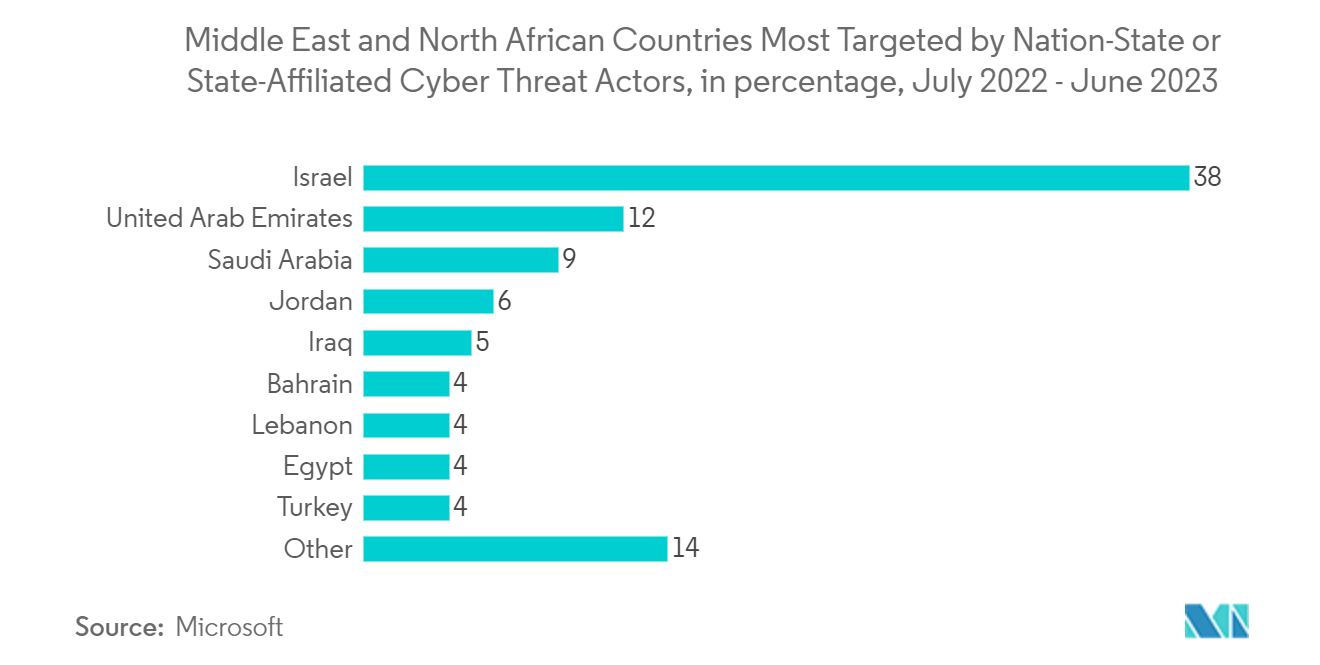
Middle East Cybersecurity Industry Overview
The Middle Eastern cybersecurity market is fragmented, consisting of established tech giants and new competitors. Some players include IBM Corporation, Fortinet Inc., Cisco Systems Inc., Trend Micro Inc., and Microsoft Corporation.
- January 2024 - Middlesex University (MDX) Dubai partnered with Fortinet by joining its Academic Partner Programme. The partnership offers a significant initiative forward in the university's commitment to elevating cybersecurity education in the UAE. As an Academic Partner, MDX Dubai will integrate Fortinet NSE certifications directly into its existing courses and facilitate the content as standalone self-paced learning for students. It also supports the UAE Cybersecurity Council, which has set out to develop a comprehensive cybersecurity strategy and a safe and strong cyberinfrastructure in the region.
- November 2023 - Trend Micro signed a Memorandum of Understanding (MoU) with Zero&One, the MENA region's pioneering Premier AWS partner with DevOps, Application Modernization, AWS Migration and Cost Optimization expertise. The partnership represents a collaborative endeavor to reshape and elevate the digital landscape through robust, advanced cloud security solutions meticulously tailored to address the region's requirements and challenges.
Middle East Cybersecurity Market Leaders
-
IBM Corporation
-
Fortinet Inc.
-
Cisco Systems Inc.
-
Trend Micro Inc.
-
Microsoft Corporation
*Disclaimer: Major Players sorted in no particular order
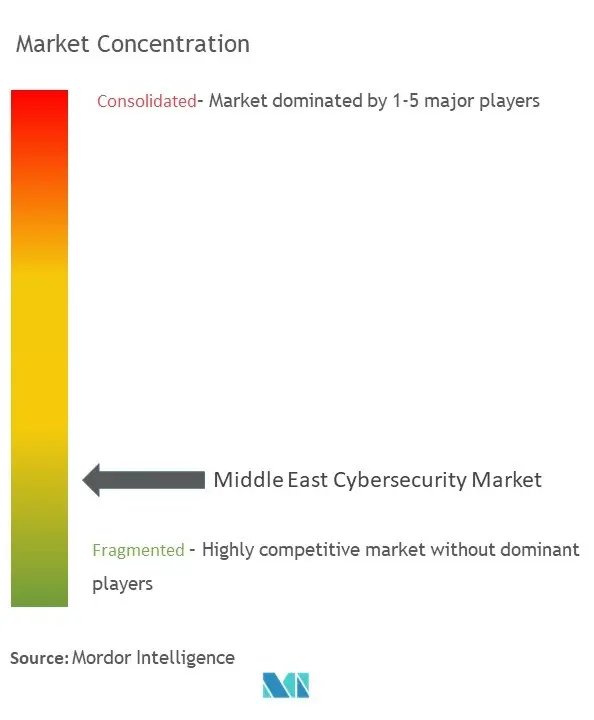
Middle East Cybersecurity Market News
- January 2024 - Trend Micro launched its Email Security, an innovative cybersecurity solution that leverages cross-generational threat techniques, including machine learning, sandbox analysis, data loss prevention (DLP), and various other methods to stop all email-based threats. This solution is expected to be hosted in the UAE for the entire Middle East and Africa region.
- October 2023 - Du, from Emirates Integrated Telecommunications Company (EITC), has signed a Memorandum of Understanding (MoU) with Microsoft to transform the digital landscape in UAE by combining Microsoft’s Azure cloud computing capabilities with Du’s network capabilities. The collaboration further fuels digital transformation for businesses while offering improved solutions in AI and cybersecurity.
Middle East Cybersecurity Market Report - Table of Contents
1. INTRODUCTION
- 1.1 Study Assumptions and Market Definition
- 1.2 Scope of the Study
2. RESEARCH METHODOLOGY
3. EXECUTIVE SUMMARY
4. MARKET INSIGHTS
- 4.1 Market Overview
- 4.2 Analysis of Macroeconomic Scenarios
- 4.3 An Assessment of the Impact of and Recovery From COVID-19
5. MARKET DYNAMICS
-
5.1 Market Drivers
- 5.1.1 Digital Transformation Technologies and Rise of Security Intelligence
- 5.1.2 High Potential Damages From Attacks on Critical Infrastructure and Increasing Sophistication of Attacks
- 5.1.3 Demand For Managed Security Service Providers (MSSPs) and Cloud-first Strategy
-
5.2 Market Challenges
- 5.2.1 High Reliance on Traditional Authentication Methods
- 5.2.2 Lack of Cybersecurity Professionals and Integration Issues
- 5.3 Opportunities For Cyber Security System Integrators in the Middle East
- 5.4 Recorded Major Cyber Attacks in the Middle East, 2020-2023
- 5.5 Government Initiatives and Regulations Related to Cyber Security
- 5.6 Technology Landscape Analysis
- 5.7 Insights on Market Entry and Expansion Strategies Adopted by Key Vendors
6. MARKET SEGMENTATION
-
6.1 By Offering
- 6.1.1 Solution
- 6.1.1.1 Cloud Security
- 6.1.1.2 Data Security
- 6.1.1.3 Identity Access Management (IAM)
- 6.1.1.4 Network Security Equipment
- 6.1.1.5 Infrastructure Protection
- 6.1.1.6 Integrated Risk Management
- 6.1.1.7 Consumer Security Software
- 6.1.1.8 Application Security
- 6.1.1.9 Other Solutions
- 6.1.2 Services
- 6.1.2.1 Professional Services
- 6.1.2.2 Managed Services
-
6.2 By Deployment Mode
- 6.2.1 Cloud
- 6.2.2 On-premises
-
6.3 By Organization Size
- 6.3.1 SMEs
- 6.3.2 Large Enterprises
-
6.4 By End-user Industry
- 6.4.1 IT & Telecom
- 6.4.2 BFSI
- 6.4.3 Retail & E-commerce
- 6.4.4 Government
- 6.4.5 Manufacturing
- 6.4.6 Healthcare
- 6.4.7 Other End-user Industries
-
6.5 By Country
- 6.5.1 Saudi Arabia
- 6.5.2 United Arab Emirates
- 6.5.3 Qatar
- 6.5.4 Kuwait
- 6.5.5 Bahrain
- 6.5.6 Rest of Middle East (Including Iraq, Jordan, Lebanon, etc.)
7. COMPETITIVE LANDSCAPE
-
7.1 Company Profiles*
- 7.1.1 IBM Corporation
- 7.1.2 Fortinet Inc.
- 7.1.3 Cisco Systems Inc.
- 7.1.4 Trend Micro Inc.
- 7.1.5 Microsoft Corporation
- 7.1.6 Broadcom Limited
- 7.1.7 Atos SE
- 7.1.8 Dell Technologies Inc.
- 7.1.9 Intel Corporation
- 7.1.10 McAfee LLC
8. FUTURE OUTLOOK OF THE MARKET
** Subject To AvailablityMiddle East Cybersecurity Industry Segmentation
Cyber security covers all aspects of the protection of an organization and its staff and assets against cyber threats. A wide range of cyber security solutions is needed in order to reduce corporate cyber risks, given the increasing frequency and sophistication of attacks, as well as more complex corporate networks.
The cybersecurity market in the Middle East is segmented by offering (solution [application security, cloud security, data security, identity & access management, network security equipment, infrastructure protection, integrated risk management, consumer security software, application security, and other solutions], services [professional services, managed services]), deployment mode (cloud, on-premise), organization size (SMEs, large enterprises), end-user industry (IT & telecom, BFSI, retail & E-Commerce, government, manufacturing, healthcare, and other end-user industries), country (Saudi Arabia, United Arab Emirates, Qatar, Kuwait, Bahrain, Rest of Middle East). The market sizes and forecasts are provided in terms of value (USD) for all the above segments.
| By Offering | Solution | Cloud Security |
| Data Security | ||
| Identity Access Management (IAM) | ||
| Network Security Equipment | ||
| Infrastructure Protection | ||
| Integrated Risk Management | ||
| Consumer Security Software | ||
| Application Security | ||
| Other Solutions | ||
| By Offering | Services | Professional Services |
| Managed Services | ||
| By Deployment Mode | Cloud | |
| On-premises | ||
| By Organization Size | SMEs | |
| Large Enterprises | ||
| By End-user Industry | IT & Telecom | |
| BFSI | ||
| Retail & E-commerce | ||
| Government | ||
| Manufacturing | ||
| Healthcare | ||
| Other End-user Industries | ||
| By Country | Saudi Arabia | |
| United Arab Emirates | ||
| Qatar | ||
| Kuwait | ||
| Bahrain | ||
| Rest of Middle East (Including Iraq, Jordan, Lebanon, etc.) |
Middle East Cybersecurity Market Research FAQs
How big is the Middle East Cybersecurity Market?
The Middle East Cybersecurity Market size is expected to reach USD 10.81 billion in 2024 and grow at a CAGR of 8.10% to reach USD 15.96 billion by 2029.
What is the current Middle East Cybersecurity Market size?
In 2024, the Middle East Cybersecurity Market size is expected to reach USD 10.81 billion.
Who are the key players in Middle East Cybersecurity Market?
IBM Corporation, Fortinet Inc., Cisco Systems Inc., Trend Micro Inc. and Microsoft Corporation are the major companies operating in the Middle East Cybersecurity Market.
What years does this Middle East Cybersecurity Market cover, and what was the market size in 2023?
In 2023, the Middle East Cybersecurity Market size was estimated at USD 9.93 billion. The report covers the Middle East Cybersecurity Market historical market size for years: 2019, 2020, 2021, 2022 and 2023. The report also forecasts the Middle East Cybersecurity Market size for years: 2024, 2025, 2026, 2027, 2028 and 2029.
Middle East Cybersecurity Industry Report
Statistics for the 2024 Middle East Cybersecurity market share, size and revenue growth rate, created by Mordor Intelligence™ Industry Reports. Middle East Cybersecurity analysis includes a market forecast outlook to for 2024 to 2029 and historical overview. Get a sample of this industry analysis as a free report PDF download.



